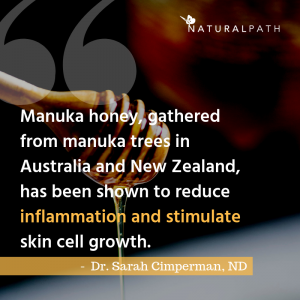Nature is good for us! Studies show that forest environments promote lower levels of stress hormones like cortisol, lower blood pressure, and better balance in the nervous system.1 Spending time outside can improve markers of immune function,2 boost levels of vitamin D, and expose us to fresh air. It also exposes us to a lot of bugs, and some are friendlier than others. Don’t let bug bites stop you from enjoying the great outdoors. Read on to learn how to prevent bug bites, how to treat them naturally, and when to see your doctor.
Prevention
Reduce your risk of bug bites by covering your head and body as much as possible and using insect repellent when necessary. Use the Environmental Working Group’s Guide to Bug Repellents to find a safe and effective repellent based on your specific needs and activities. Once you come inside after spending time outdoors, check your entire body for ticks and other insects that may have attached themselves to your skin.
Safe Removal
If you find an insect or its stinger attached to your body, it’s important to remove it safely and as soon as possible. For ticks, grasp the head of the tick as close to the skin as you can using a tweezers and exert slow, even, upward pressure until it is released. For stingers, scrape them away and avoid using tweezers. When bugs sting, a venom pouch is often dislodged and remains with the stinger. Squeezing the venom pouch when the stinger is still attached can release more venom into the skin.
Natural Remedies
When the bugs do bite, use natural remedies to soothe irritation and help the body heal.
Here are 8 ways to treat bug bites naturally
#1 | Cold Compress
A cold compress can reduce pain and swelling associated with bug bites. It can be applied using an ice bag or a wet towel wrapped around ice cubes.
#2 | Manuka Honey
Honey has anti-inflammatory and anti-microbial properties. It also contains nutrients needed for tissue repair and rejuvenation. One variety in particular, manuka honey, comes from bees that gather nectar from manuka trees in Australia and New Zealand. It’s been shown to reduce inflammation and stimulate skin cell growth3 so it’s my first choice for bug bites. If manuka honey isn’t available, use raw honey from a local beekeeper. Apply it directly to bug bites and cover for several hours. Avoid pasteurized products because treating honey with heat destroys many of its healing compounds.
#3 | Onion Poultice
Onions contain the anti-inflammatory bioflavonoid quercitin as well as enzymes that break down prostaglandins, which are chemicals released by the body to signal pain. You can make your own onion poultice by cutting a raw onion in half and placing the freshly cut side against the affected area for thirty minutes.
#4 | Baking Soda Paste
Because baking soda is alkaline, it can neutralize acids in insect venom. It’s easy to apply as a paste to bites and stings. Mix enough water with a spoonful of baking soda to make a paste, then spread it over the affected area and allow it to dry.
#5 | Essential Oils
Pure organic essential oils have antiseptic and anti-inflammatory properties that are useful for relieving pain and itching associated with bug bites. Lavender and tea tree essential oils are good choices because they can be applied directly to the skin without diluting in a carrier oil. Never apply essential oils to open skin and always avoid perfume oils and fragrance oils.
#6 | Vinegar Bath
Vinegar diluted in water can be used to sooth large areas of itchy bites. Add thirty-two ounces of vinegar to a tepid bath and soak for 30 minutes.
#7 | Plantain Poultice
Plantain, known botanically as Plantago major, is an edible and medicinal plant. The leaves can help draw out inflammatory secretions and insect venom from the skin. Plantain also has anti-microbial and pain-relieving properties, so it’s a great first aid tool when you’re in the wilderness. It grows close to the ground and has unevenly toothed leaves, four to ten inches long, growing from a central root. If you can correctly identify this plant, make a poultice by chewing or mashing the leaves into a pulp. Apply it directly to the bite or sting until the pain subsides.
#8 | Homeopathic Remedies
Homeopathic remedies for bites and stings include Ledum, Apis Mellifica, Arnica Montana, and Carbolic Acid. Use Ledum for bites that are inflamed, swollen, cold, and numb, and when the person bitten feels chilly. Apis Mellifica is specific for stinging, burning pain with rapid swelling, especially if the sting came from a bee. Arnica Montana is a good choice when bug bites feel sore. Carbolic Acid is used for itchy blisters and hives. Homeopathic remedies may be taken orally as sublingual pellets and or used topically in creams and ointments. Creams containing homeopathic remedies are usually not antiseptic, so if the skin has been broken, choose oral over topical use.
Caution
Some insects can transmit serious disease. Ticks can transmit Lyme disease or Rocky Mountain Spotted Fever. Mosquitoes may be carriers of the West Nile virus. And some spiders are poisonous. Anyone who becomes ill after a bite should seek medical attention. This includes people who develop a rash or flu-like symptoms such as fever, chills, and body aches. People who have wounds that do not heal should also see their doctor without delay.
References:
1 Park BJ, Tsunetsugu Y, Kasetani T, Kagawa T, and Miyazaki Y. The physiological effects of Shinrin-yoku (taking in the forest atmosphere or forest bathing): evidence from field experiments in 24 forests across Japan. Environmental Health and Preventive Medicine. 2010;15(1):18-26. https://www.ncbi.nlm.nih.gov/pubmed/19568835
2 Li Q. Effect of forest bathing trips on human immune function. Environmental Health and Preventive Medicine. 2010;15(1):9-17. https://www.ncbi.nlm.nih.gov/pmc/articles/PMC2793341/
3 Eteraf-Oskouei1 T and Najafi M. Traditional and Modern Uses of Natural Honey in Human Diseases: A Review. Iranian Journal of Basic Medical Sciences. 2013;16(6):731-742. https://www.ncbi.nlm.nih.gov/pmc/articles/PMC3758027/
 Sarah Cimperman, ND is the author of the new book, The Prediabetes Detox: A Whole-Body Program to Balance Your Blood Sugar, Increase Energy, and Reduce Sugar Cravings. She graduated from NCNM in 2002 and has a private practice in New York City. Her expertise has been featured on Fox News and Huffington Post and in Natural Health magazine, Whole Living magazine, and the Well Being Journal, among other publications. Dr. Cimperman also writes two blogs, A Different Kind Of Doctor and The Naturopathic Gourmet.
Sarah Cimperman, ND is the author of the new book, The Prediabetes Detox: A Whole-Body Program to Balance Your Blood Sugar, Increase Energy, and Reduce Sugar Cravings. She graduated from NCNM in 2002 and has a private practice in New York City. Her expertise has been featured on Fox News and Huffington Post and in Natural Health magazine, Whole Living magazine, and the Well Being Journal, among other publications. Dr. Cimperman also writes two blogs, A Different Kind Of Doctor and The Naturopathic Gourmet.
